|
JOINT COMMISSION WORKING GROUP ON
UNDER-REPRESENTED GROUPS IN SURVEYING
 Visit the Web site of the
FIG Working Group on Under-represented Groups in Surveying
Visit the Web site of the
FIG Working Group on Under-represented Groups in Surveying
 This Newsletter in -pdf-format
This Newsletter in -pdf-format
Contents
German Network „Women in DVW“ by
Gabriele Dasse, Germany
Retirement of Baby Boomers Affecting
Canadian Land Surveyors by Marie Robidoux, Canada
Dr. Ing. Efstratia Zafeirou - A Greek woman,
Mechanical Engineer is leading AUDI
German Network „Women in DVW“
by Gabriele Dasse, Germany
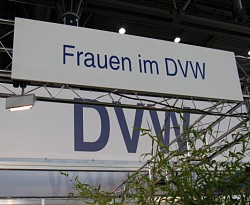
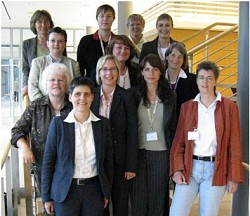
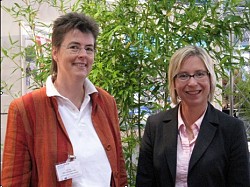
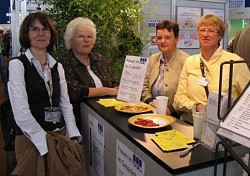 |
The German Association of Surveying (DVW), Society for
Geodesy, Geoinformation and Land Management (member association
of FIG) held its annual congress and trade fair this year in
Leipzig. Leipzig is a City of 505000 inhabitants in Eastern
Germany (North-west of Saxony), the largest city in Saxony and
the twelfth largest in Germany. In total 16.500 visitors from
more than 50 countries visited the trade fair, approximately one
third came the first time. 1.500 national and international
experts attended the congress.
The Congress is a very good opportunity for a meeting of the
network “Frauen im DVW” (“Women in DVW”). The network is
supported financially by DVW and the chair and one member of the
network are members of the DVW Working Group “Profession”
(comparable to Commission 1 and 2 of FIG) as well. This year the
19th annual meeting of the women’s network took place in
September 2007. Thirteen women from all over the country met in
this session. The network organises a lot of activities to
promote and support women in the field of surveying profession.
During the session organisational and financial aspects were
discussed and proposals made for several activities in 2008. The
activities organised during the last year were evaluated.
Reports from the DVW Working Group 1 and the FIG Network
“Under-represented Groups in Surveying” are elements of this
meeting as well.
During the last 4 years the Group was chaired by Sonja
Andresen (in the photograph on the right sight) and Elke
Schultze-Graf. They made an excellent job and were elected
again without a dissentient vote for another 4 years. Their next
activity will be to organise a workshop including a seminar
“Rules and Power Games in Profession”. Topic of the seminar is
to exercise strategies to use the rules in the right way and to
defend oneself from power games (for example of male colleagues
or bosses). We are hoping to meet there a lot of female
colleagues to learn together and share experiences.
The network is represented at the DVW booth in the exhibition
area during the INTERGEO, which offers a good opportunity to
contact female and male colleagues. The whole time (except
during the session) in minimum one women is there present for
discussions or to inform about the network and DVW. This year
was the first time that discussions were offered concerning
special subjects (for example: mentoring; the advantages to be
involved in DVW; female, young and boss). For us the booth is a
fantastic meeting place, especially after the session.
Gabriele Dasse, Germany
email: g.dasse@gmx.de |
Retirement of Baby Boomers
Affecting Canadian Land Surveyors
by Marie Robidoux, Canada
Canada is currently facing a very difficult situation: 30% of the
Canadian population are baby boomers - a baby boomer is a person born
between 1945 and 1965 in the United Kingdom, the United States, Canada,
or Australia. Following World War II, these countries experienced an
unusual spike in birth rates, a phenomenon commonly known as the baby
boom.
The situation in Canada is not so different from the one encounter in
other countries affected by the baby boom such as Australia. The problem
is exacerbated by the strong Canadian economy which is expanding and
hence requiring more workers. Neither the Canadian birthrate nor
immigration are seen to be able to fend the tide of baby boomers
retiring. Although many will keep working longer, there will still be a
huge gap to fill. It is acute in many professions and most trades.
Canada is the world's second largest country in geographical size
(Russia being the largest). Canada’s population in 2007 is approximately
33,390,141 spread over 9,984,670 sq km of which 91% is land and 9% is
water. Canada has less than 3,000 land surveyors licensed to carry out
cadastral surveys.
Professional land surveyors in Canada are regulated through 11
separate, self-regulated associations – one for each 10 provinces; and
one for the three northern territories (Yukon, Northwest Territories and
Nunavut), National Parks and Indian Reserves wherever they are located
in the country, and Canada’s offshore.
Of course this is not a situation specific to surveying but affecting
all professions across the country and this makes it even more difficult
to attract new recruits as the competition is intense.
The first wave of baby boomers reached retirement age last year and
this phenomenon will only accelerate in the next decades. Some of the
survey associations have more than half of their members looking at
retirement within the next few years. In several Canadian land surveyors
associations the average age of members is 55.
In some associations, the number of new members is staying steady
while in others numbers are dwindling. The has now reached a crisis
level and some very focused initiatives are underway in a few provinces
to try and attract more young people into the profession.
Every survey association in Canada is member of the Canadian Council
of Land Surveyors (CCLS) which is an association of associations. A new
initiative spearheaded by CCLS is to provide a national vision paper for
surveying in Canada around which to rally the member associations to
proactively meet the future through coordinated initiatives including
attracting more members to the profession.
Some of the initiatives currently underway and spearheaded by
governments are Labour Mobility Agreement between 10 of the 11 land
surveying associations in Canada making it easier for a professional
land surveyor to practice in a different Canadian jurisdiction than his
or her home association.
Even more bold is the Trade, Investment and Labour Mobility Agreement
(TILMA) between the provinces of British Columbia and Alberta where
“Each Party shall ensure that its measures do not operate to impair or
restrict trade between or through the territory of the Parties, or
investment or labour mobility between the Parties.” Currently, more than
60 occupations have been identified as having different standards that
limit labour mobility between the two provinces. British Columbia and
Alberta are to work with occupational regulators to reconcile these
standards by April 1, 2009. An omnibus bill, that will amend provincial
legislation as required to make it compliant with TILMA, will then be
drafted and introduced to the Legislature in February 2008. This
obligates the respective land surveying associations to come up with a
satisfactory way (to their government) of accepting each others’ members
in their own associations in a very simple way such as for example
passing a Statute Law exam as this is different in each land surveying
jurisdiction. Currently for a British Columbia Land Surveyor to become
an Alberta Lands Surveyor, one must write and pass with 75% three exams:
Practical Surveying Exam, The Statute Law Exams, and the Surveying
Profession Exam; and three 2-4 page project reports on a Parcel
Survey/Subdivision (must be a plan of survey); a stand-alone
Right-of-Way or Road Survey; and a member selected project on suggested
topics such as a Real Property Report, a condominium survey, a wellsite
survey, or a relevant engineering survey.
Other provinces are watching carefully the developments in BC and
Alberta and some are convinced that they too will be faced with some
version of TILMA. Studies and reports are being done to better be
prepared for such an eventuality. BC and Alberta did not have the luxury
of preparation as this was foisted upon them by their respective
governments without consultation.
It may take years to reverse but many are hopeful that it is not too
little too late – for decades the land surveyor has toiled in the
background and often as an addendum to major projects. Never was
surveying put on par with other disciplines such as engineering.
Although the surveyor, amongst a plethora of professionals, is often
first and last onsite, no one has been blowing the horn about the major
contribution that a land surveyor brings to any project.
Canada has a large Aboriginal population and over the next 10 years
it is expected that aboriginal youths entering the workforce (age 20 to
29) will increase by 40%. This segment of the Canadian population is one
where many are still living a more or less traditional lifestyle off the
land. They are outdoors enthusiasts, they know the land in a way that
many Canadians do not. Their affinity with the land seems to make a
perfect fit for a surveying career. However most do not graduate from
high school. Efforts are needed to address this and bring more
Aboriginal youth to surveying as a career. Similarly the women
population is one where surveying is not even remotely considered as a
potential career. Land surveyors have to do a better selling job to
reach these pools of workers.
It seems that crisis always bring to the fore all the details that no
one has paid attention to when the “going was good”. Well that time is
here now and the details are being attended to – but are it too late?
Only time will tell.
Marie Robidoux, Canada
E-mail:
mrobidoux@challengergeomatics.com
A Greek woman, Mechanical Engineer is leading AUDI
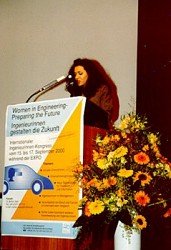 |
She is a young lady, married, mother of three small
children; she was born in Greek countryside (Chalkidiki). She
studied as Mechanical Engineer at the AUTH (Aristotle University
of Thessaloniki). In 1998 she obtained her doctoral thesis in
the sector “Thermodynamics and Strobilomichanes” of the
University of Karlsruhe. In 2005 she undertook the address of
the Department of Research of - Market of Audi that it resides
in Ingolstadt of Bavaria. She never had herself the dilemma
between career and family. She believes that a woman can be also
woman and engineer and mother, and also to take part in other
activities. This attitude of life has, however, her price: she
has never time for herself, because she works long times and any
her free time dedicates in her children. “This is the price that
I pay but I know it. I make it voluntarily and I know very well
that this is something that will accompany me in my life. I make
it, however, with very big pleasure and I believe that I am good
mother, because I am good in my work ", she said in a Deutse
Welle interview. |
In congresses, interviews, seminars that she organises herself in her
company, but also in the old days, as a Boarding Member of the German
Association of Women Engineers, she supports vigorously the necessity of
promotion of feminine executives.
She is worldwide known as woman example between other women who have
power in the hands their, women that they play a leading part in their
professional sector.
Eleni Tziortzioti, Greece
E-mail: ltzio@dpers.minenv.gr
LINKS of Associations for Women Engineers
|
Editors: Eleni Tziortzioti (Greece), Angela
Kesiena Etuonovbe (Nigeria), Marie Robidoux (Canada)
1/08, month of issue:
January
© Copyright 2008 Eleni Tziortzioti, Angela
Kesiena Etuonovbe and Marie Robidoux
Permission is granted to photocopy in limited quantity for educational
purposes.
Other requests to photocopy or otherwise reproduce material
in this newsletter should be addressed to the Editor.
|
|




























